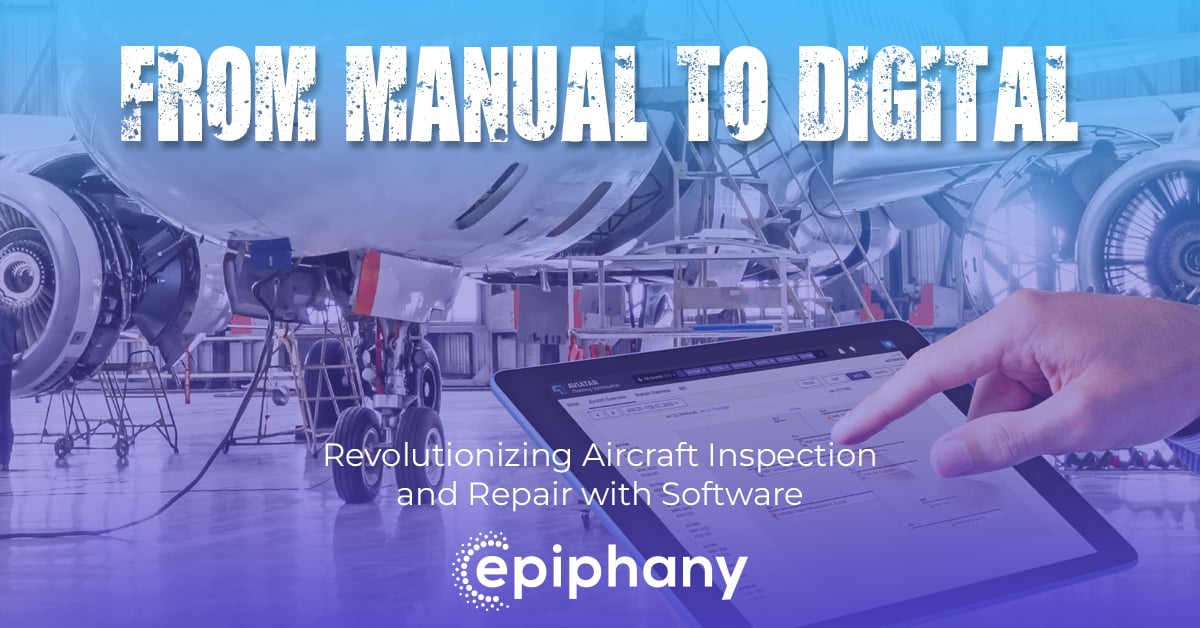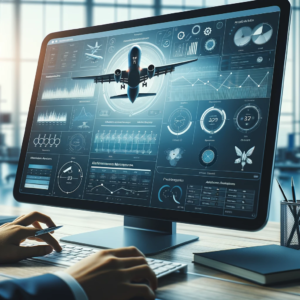In the realm of aviation, where safety was paramount and precision was king, a quiet revolution was stirring. Picture this: a world where aircraft inspections and repairs were conducted with stacks of paperwork, grease-stained manuals, and the skilled hands of mechanics. But as technology raced ahead, a new chapter began to unfold.
This is a tale of how the analog past transitioned into the digital future, a story where innovation and ingenuity took center stage.
In this article, we invite you on a journey that will whisk you away from hangars to virtual landscapes, where the heroes aren’t pilots in cockpits but lines of code and digital tools. So, fasten your seatbelts, dear readers, because we are about to delve into the captivating narrative of how software has reshaped the world of aircraft inspection and repair, ushering in an era of heightened safety and efficiency.
The Challenges of Manual Aircraft Inspection
In the bygone days of manual aircraft inspection, the hangars echoed with the sounds of mechanics meticulously going through endless checklists. The first challenge we encountered on this journey was the labor-intensive nature of these processes.
Think of it this way – teams of skilled technicians spending hours upon hours poring over paper documents, examining every nook and cranny of an aircraft. It was a true labor of love, but it came at a cost. Not only did it demand significant manpower, but it also meant that skilled professionals were tied up in routine inspections, diverting their expertise from more critical tasks.
Now, let’s talk about human error and inconsistency, a chapter in this story that often had a bitter twist. Despite the diligence of these aviation heroes, they were still human, prone to the occasional oversight or inconsistency.
Imagine the stress of knowing that a small error in inspection could have monumental consequences. It wasn’t just about human error; it was about the inherent variability in how different individuals conducted inspections. Each mechanic brought a unique touch, which, while admirable, could lead to inconsistencies in the process.
As we continue our narrative, we come to the issue of time-consuming inspections. Back in those days, time was a luxury that aircraft inspections couldn’t afford. A single inspection could take days, grounding aircraft and causing delays that rippled through schedules and budgets. This wasn’t just a logistical headache; it was a financial one too.
And last but not least, the tale wouldn’t be complete without discussing the limited data storage and analysis capabilities of manual methods. Imagine trying to keep track of inspection records for an entire fleet of aircraft with stacks of paper.
It was like trying to hold an ocean in a teacup. Not only was it impractical, but it also meant that valuable insights from historical data were often left untapped. The lack of robust data storage and analysis capabilities hindered the aviation industry’s ability to make informed decisions and proactively address maintenance issues.
The Digital Transformation of Aircraft Inspection
In the annals of aviation history, where aircraft inspections were once synonymous with stacks of paperwork and exhaustive manual checks, a digital transformation emerged as a beacon of change.
The advent of digital inspection software was akin to technological wizardry that infused new life into the maintenance routine. These software systems, equipped with advanced algorithms and real-time capabilities, became the trusted companions of aviation mechanics.
With their arrival, a revolution took flight, fundamentally altering the landscape of aircraft inspections.
The transition to digital inspection software came bearing a multitude of tangible benefits, backed by facts and figures.
Improved Accuracy
Digital inspection software brought forth an astonishing level of accuracy. In comparison to manual inspections with their inherent margin for human error, these digital tools demonstrated a remarkable reduction in discrepancies. Studies have shown that the accuracy rate in identifying defects and potential issues increased significantly, thereby enhancing aviation safety.
Time and Cost Savings
The impact of this digital shift on time and costs was nothing short of revolutionary. Research indicates that the time required for inspections was reduced by up to 50%.
This translated into substantial cost savings for airlines, with a direct correlation between the reduction in labor hours and improved operational efficiency.
Enhanced Safety
Safety became the central theme of this transformation. Digital inspection software didn’t just passively identify existing issues; it actively predicted potential ones. Statistics show that predictive maintenance, made possible by these digital tools, led to a significant decline in in-flight incidents and unplanned maintenance events, ultimately ensuring safer skies.
Data-Driven Decision-Making
The digital era ushered in an era of data-driven decision-making. With each inspection, a wealth of data was generated. Notably, this data wasn’t just relegated to storage; it became a strategic asset. Aviation industry reports underscore the fact that data-driven decision-making led to a substantial reduction in maintenance costs and improved aircraft reliability.
Key Features of Aircraft Inspection Software
Imagine having a trusty companion in the world of aviation maintenance, a digital assistant that provides you with meticulously crafted inspection checklists and templates. This is precisely what aircraft inspection software brings to the table. These software solutions come equipped with pre-designed checklists tailored to specific aircraft models and regulatory requirements.
It’s like having a seasoned expert by your side, ensuring that no crucial inspection step is overlooked. This feature is not just a convenience; it’s a practical necessity that saves time and minimizes the chances of human error, contributing to safer flights.
Integration with Sensors and IoT Devices
In the digital age, aircraft inspection software doesn’t operate in isolation; it’s part of a connected ecosystem. One of its remarkable features is seamless integration with sensors and Internet of Things (IoT) devices. These sensors are strategically placed throughout the aircraft, constantly collecting data on various components and systems.
The software harnesses this real-time data flow, turning it into actionable insights. This integration isn’t just a cool tech trick; it’s a game-changer. It allows for early detection of anomalies, potential issues, and even predictive maintenance, ultimately bolstering safety and efficiency.
Real-Time Data Collection and Analysis
Gone are the days of collecting inspection data on paper, only to manually enter it into a computer later. With aircraft inspection software, real-time data collection and analysis take center stage. While the inspection is ongoing, the software captures data instantly, offering an up-to-the-minute view of the aircraft’s condition.
This real-time feature isn’t just about speed; it’s about informed decision-making. It empowers maintenance teams to take immediate action if any irregularities are detected, thus minimizing downtime and ensuring that aircraft are always in prime condition.
Mobile Accessibility
Imagine having the power of aircraft inspection software in the palm of your hand. Many of these software solutions offer mobile accessibility, allowing mechanics and inspectors to carry out their duties using smartphones or tablets.
This mobility isn’t just a convenience; it’s a productivity booster. Mechanics can access inspection checklists, record data, and even communicate with team members on the go, making inspections more efficient and flexible.
Automated Reporting and Documentation
Last but not least, consider the hassle of manual paperwork and documentation in traditional inspections. Aircraft inspection software sweeps away this paperwork nightmare by automating reporting and documentation.
Once an inspection is completed, the software generates comprehensive reports, complete with all the inspection data, analysis, and any identified issues.
This automation isn’t just about reducing administrative burdens; it’s about accuracy. Reports are consistent, error-free, and compliant with regulatory standards, ensuring that aviation authorities are satisfied and aircraft remain airworthy.
Case Studies: Successful Implementation
Let’s step into the real world of aviation and discover how aircraft inspection software has been a game-changer for organizations. Picture this: airlines and maintenance teams, from major players to regional carriers, have embraced this digital shift with open arms.
For instance, GE Aerospace has developed the Sensiworm, a soft robotic inchworm that can perform on-wing engine inspections and repairs, reducing the need for engine removal and improving efficiency.
Demonstrating the Positive Impact
But it’s not just about numbers; it’s about the tangible impact on efficiency and safety. Take the case of a regional carrier that implemented these digital tools.
The result? Fewer unscheduled maintenance events, which means fewer flight delays and cancellations, ultimately leading to happier passengers and improved reputation.
Moreover, their maintenance teams reported enhanced job satisfaction, as they could focus on critical tasks rather than drowning in paperwork.
Lessons Learned
Now, let’s delve into the lessons learned from these implementations. One resounding lesson is that technology is a formidable ally. It’s not here to replace human expertise but to enhance it.
Teams that embraced this digital transformation in aerospace discovered that their skilled mechanics could dedicate more time to high-value tasks, such as troubleshooting complex issues.
Another key lesson is the importance of adaptability. In the dynamic world of aviation, software updates and evolving regulations are the norm. Organizations that thrived in this digital age were those that remained flexible, ready to adapt to new features and compliance standards
Challenges and Considerations
In the present age of digital transformation, one of the dragons that organizations must face is the beast of data security and privacy concerns. Think of it as guarding the treasure chest of sensitive inspection data. With aircraft inspection software, a wealth of critical information is generated and stored digitally.
This includes data on aircraft conditions, maintenance schedules, and more. So, it’s no surprise that safeguarding this data becomes a paramount concern. Organizations must invest in robust cybersecurity measures to protect against potential breaches and ensure that sensitive data remains confidential.
Training and Adoption Issues
Now, think of this challenge: introducing new technology to a team that has been accustomed to traditional, manual inspection methods for years. It’s like teaching an old dog new tricks. The adoption of aircraft inspection software can be met with resistance or hesitation among some team members.
It requires comprehensive training programs to familiarize mechanics and inspectors with the software’s features and functionalities. Ensuring a smooth transition from manual to digital is crucial for achieving the full benefits of the technology.
Regulatory Compliance
Navigating the labyrinth of aviation regulations is no small feat. Aircraft inspection software must adhere to stringent industry standards and regulations set forth by aviation authorities. Meeting these compliance requirements isn’t just a matter of ticking boxes; it’s a critical consideration.
Failure to comply could result in costly penalties or even the grounding of aircraft. Organizations need to carefully choose software solutions that align with these regulations and can adapt to evolving compliance standards.
Integration with Existing Systems
Lastly, think of aircraft inspection software as a new arrival at a family gathering. It needs to fit in seamlessly with the existing family dynamics. Organizations often have other systems and software in place, such as maintenance management systems.
Ensuring that the new aircraft inspection software integrates smoothly with these existing systems is essential for data flow and operational efficiency. The challenge here lies in achieving this integration without disrupting ongoing operations.
In the grand story of aircraft inspection software adoption, these challenges and considerations are the hurdles that organizations must overcome. They are the dragons that must be tamed on the path to a more efficient and digitized aviation world.
The Evolution of Drones
The aviation industry has witnessed a remarkable transformation with the integration of drones into aircraft inspection processes. Once upon a time, the inspection of an aircraft after landing and during scheduled maintenance intervals required a human inspector to crawl all over the plane, meticulously noting every dent, scratch, or potential issue. It was a labor-intensive and time-consuming task.
However, with the advent of drone technology, this narrative has taken a futuristic turn.
Imagine this scenario: as a plane touches down, a drone, equipped with advanced sensors and cameras, takes flight. It conducts a comprehensive visual inspection of the aircraft’s exterior.
These drones are like vigilant sentinels of the skies, capturing high-resolution images and data of the entire aircraft surface. This data includes not only visible issues but also those that may be hidden from the human eye, such as stress fractures or structural anomalies.
The real magic happens with what comes next: the data collected by these inspection drones is a treasure trove of information. It goes beyond mere visual records. Using sophisticated algorithms and machine learning, the data is analyzed in real time.
It identifies potential issues, assesses their severity, and records them digitally. This wealth of information can be processed and stored in various formats, from printable reports to CSV files for convenient data management.
But what makes this data truly remarkable is its potential. It becomes a digital blueprint of the aircraft’s condition over time. Maintenance teams can access this historical data to track the progression of issues, make data-driven decisions on maintenance schedules, and even predict future maintenance needs.
It’s like having a digital diary of an aircraft’s health, enabling more proactive and efficient maintenance practices.
In the end, the integration of drones into aircraft inspection will not only streamline the inspection process but also empower the aviation industry with valuable, actionable data. It’s a technological leap that enhances safety, reduces downtime, and marks a new chapter in the history of aviation maintenance.
Future Trends in Aircraft Inspection Software
The future of aircraft inspection software is nothing short of exhilarating, with several exciting trends poised to redefine the aviation industry.
Artificial Intelligence and Machine Learning
Imagine having an inspection software that not only collects data but also learns from it. Artificial intelligence (AI) and machine learning (ML) are propelling aircraft inspection into a new era.
These smart systems can recognize patterns, anticipate maintenance needs, and even suggest optimal repair strategies. They’re like the Sherlock Holmes of aviation, constantly honing their detective skills to ensure aircraft safety and efficiency.
Predictive Maintenance
The future will be marked by predictive maintenance – a crystal ball for aircraft health. Using data collected by inspection software and AI algorithms, organizations can forecast when components may fail or require maintenance.
This proactive approach minimizes unscheduled downtime, reduces operational costs, and keeps aircraft in peak condition. It’s like having a fortune teller for aircraft maintenance.
Augmented and Virtual Reality Applications
Augmented and virtual reality (AR/VR) are making their grand entrance into aircraft inspection. Mechanics can don AR glasses, overlaying vital information onto their field of vision. It’s akin to having an expert right beside you, guiding you through inspections step by step.
VR simulations also enable realistic training scenarios for new inspectors. These technologies are transforming inspection processes, making them more efficient and less error-prone.
Blockchain for Data Integrity
Data integrity is paramount in aviation, and blockchain technology is stepping in to ensure it. Blockchain creates an immutable ledger of inspection data, making it virtually tamper-proof. This level of data security and trustworthiness is invaluable, especially when it comes to critical maintenance records and compliance with aviation regulations.
Sustainability and Environmental Considerations
The aviation industry is becoming increasingly conscious of its environmental footprint. Future aircraft inspection software will likely incorporate sustainability metrics. It will enable organizations to track the environmental impact of their maintenance activities and make more eco-friendly choices. It’s about not only ensuring safety but also contributing to a greener aviation future.
These trends are more than just futuristic concepts; they are actively shaping the landscape of aircraft inspection software, ushering in an era of smarter, safer, and more sustainable aviation maintenance practices.
Choosing the Right Aircraft Inspection Software
Choosing the right aircraft inspection software is akin to selecting the perfect tool for a craftsman. It requires careful consideration of various factors. First and foremost, assess your specific needs and requirements. What kind of inspections do you conduct?
What data do you need to capture? Understanding your unique needs is the foundation of the selection process.
Vendor Selection and Evaluation
Selecting the right vendor is like choosing a trustworthy partner. Research and evaluate potential software providers meticulously. Consider their track record in the aviation industry, their reputation for reliability, and their customer support.
Look for user reviews and testimonials to get a sense of their software’s performance in real-world scenarios.
Customization and Scalability Options
One size doesn’t fit all in the world of aircraft inspection software. It’s essential to choose a solution that offers customization options. Can the software be tailored to match your specific inspection processes and workflow? Moreover, consider scalability. Will the software grow with your organization as your needs evolve? Ensure that it can adapt to future challenges and expansion.
Cost Analysis and ROI Assessment
Cost is a critical factor, but it goes beyond the initial purchase price. Consider the total cost of ownership, including implementation, training, and ongoing maintenance. Calculate the potential return on investment (ROI) by assessing how the software can increase inspection efficiency, reduce downtime, and improve safety. It’s like evaluating an investment – you want to ensure it brings value to your organization.
How Epiphany Can Help
Imagine this: You’re in the cockpit of a passenger plane, ready to take off on a journey. You want the reassurance that every component of that aircraft has been meticulously inspected and maintained, ensuring your safety throughout the flight. This is where Epiphany comes in – they’re the guardians of aircraft maintenance.
With their tailored solutions for aviation MRO, they take equipment management to a whole new level. When planes are maintained by Epiphany, safety is paramount. Their expertise in repair management, project profitability, and contract management means that every nut, bolt, and system is in top-notch condition.
So, the next time you board a plane, you can have peace of mind knowing that Epiphany has played a crucial role in making your journey safer and more reliable.
Wrapping Up
In conclusion, the world of aircraft inspection has undergone a remarkable transformation, driven by the advent of advanced inspection software and innovative technologies. We’ve journeyed through the evolution from manual inspections to the digital era, where drones and AI-driven software have become the superheroes of aviation maintenance.
As we’ve explored, the future of aircraft inspection software holds promise in the realms of artificial intelligence, predictive maintenance, augmented reality, and sustainability considerations.
However, the path to selecting the right aircraft inspection software is not without its challenges. It involves careful evaluation of factors, vendor selection, customization, scalability, and cost analysis to ensure that the chosen solution aligns seamlessly with an organization’s needs and goals. So, our dear readers, apply innovation, and be safe!






